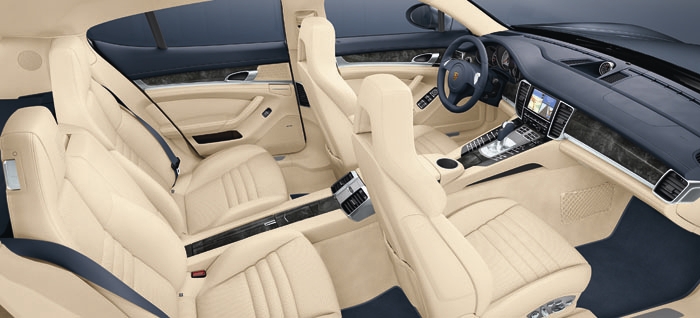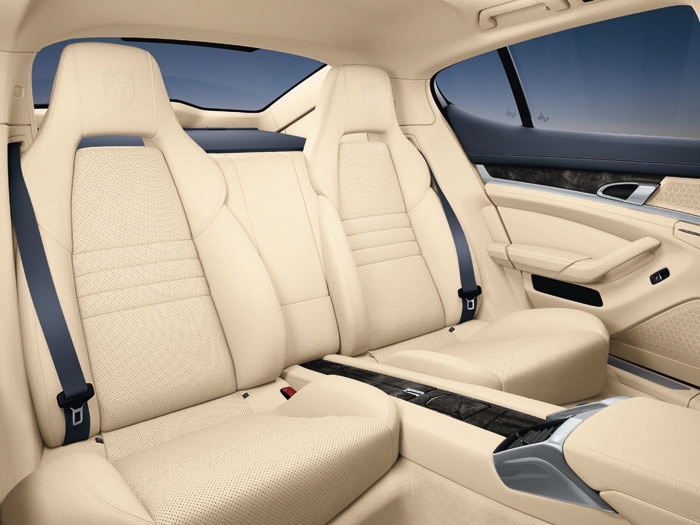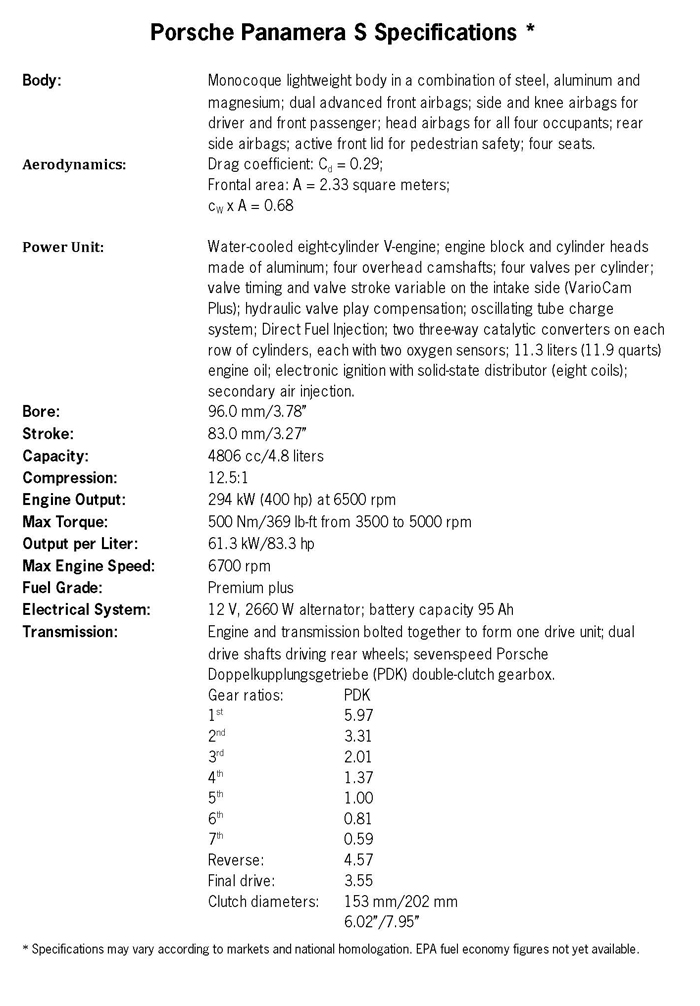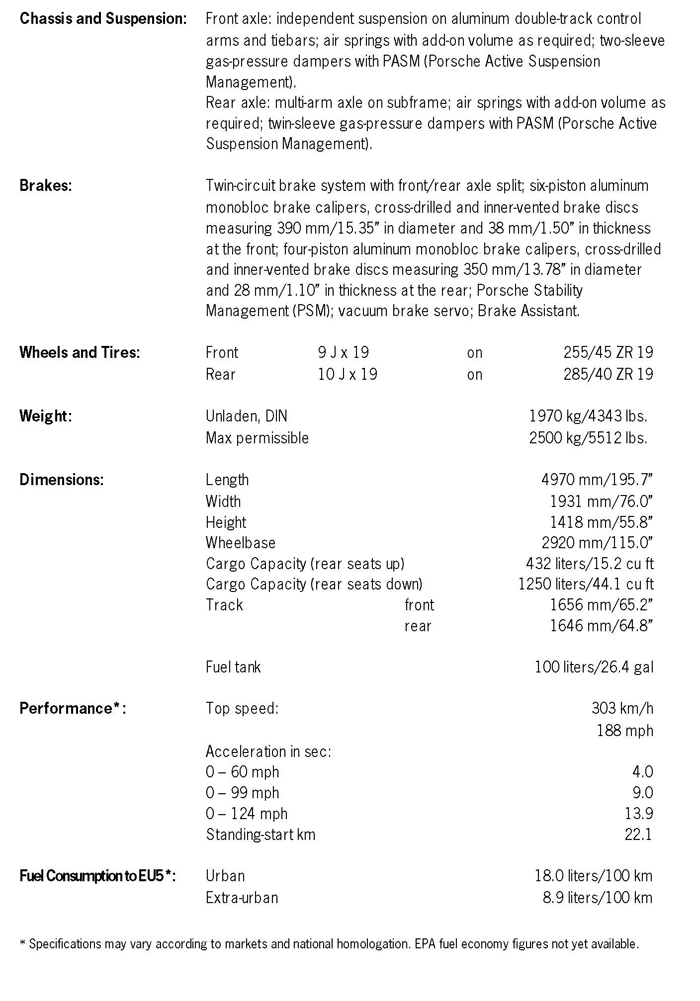
With the Panamera, Porsche’s fourth model line, customers will see an unprecedented vehicle concept – a four-seat gran turismo offering both dynamic performance and superior elegance all in one. While competing with well-established models in the premium class, the Panamera carves a new niche in terms of performance, driving dynamics and efficiency. This is familiar ground as efficient, high-performance engines, lightweight engineering and optimized aerodynamics have been Porsche core competencies throughout its 60-year history both on and off the race circuits.

Automatic Engine Start/Stop Function Among Several New Technologies to be Featured on Porsche’s Upcoming Four-Seat Gran Turismo
As the moment draws near when the Porsche Panamera makes its public debut at the Shanghai Motor Show on April 19, 2009, the Stuttgart, Germany based auto manufacturer reveals a few more technical details to whet the appetites of those in search of the emotional and driving character of a sports car coupled with the high luxury and interior comfort of a performance sedan in one unique vehicle that is still instantly recognized as a Porsche.
When it goes on sale in the United States on Oct. 17, 2009, the Panamera will showcase some innovative technologies. These include the first automatic engine start/stop feature used with an automatically shifting double-clutch transmission, air suspension with additional air volume on demand, and on the Panamera Turbo active aerodynamics with a multi-stage, adjustable rear spoiler that deploys when needed.
With the Panamera, Porsche’s fourth model line, customers will see an unprecedented vehicle concept – a four-seat gran turismo offering both dynamic performance and superior elegance all in one. While competing with well-established models in the premium class, the Panamera carves a new niche in terms of performance, driving dynamics and efficiency. This is familiar ground as efficient, high-performance engines, lightweight engineering and optimized aerodynamics have been Porsche core competencies throughout its 60-year history both on and off the race circuits.

Maximum performance and efficiency
The Panamera is the first premium car with an automatically shifting double-clutch transmission to feature an engine start/stop system that saves fuel and reduces emissions by turning the engine off when it is not needed, such as sitting at a stop light, for example. All engines have advanced and fuel-efficient Direct Fuel Injection (DFI), as well. In addition to consistently reducing friction in their engines, Porsche further enhanced the engines with innovations such as map-controlled coolant/temperature management and ancillary units with enhanced efficiency.
The Porsche Doppelkupplungsgetriebe (PDK) double-clutch gearbox, standard on all U.S. Panamera models and a first in this market segment, also enhances both fuel economy and performance. Being more efficient than a conventional automatic transmission, the PDK gearbox can save even more fuel through its long, overdrive-like top gear. It offers outstanding performance with typical Porsche driving dynamics through ultra-fast gearshifts without the slightest interruption of engine power.
In conjunction with other specific improvements enhancing overall efficiency, including tires with minimal rolling resistance and disc brakes with residual brake forces reduced to a minimum, the Panamera S consumes just 10.8 liters/100 kilometers (equal to 26.2 mpg imp) in the New European Driving Cycle (EPA fuel economy figures are not yet available).
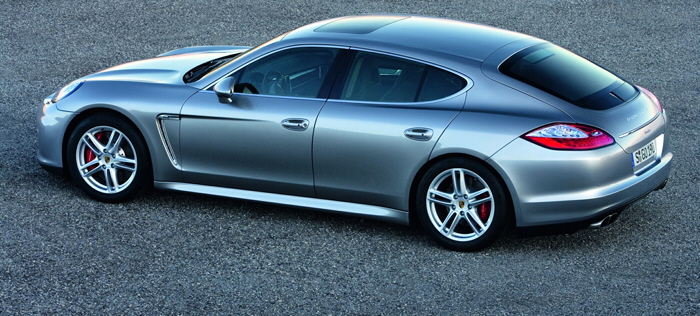
Chassis and suspension: driving dynamics and comfort all in one
The Panamera chassis and suspension is not a compromise between sporting performance and superior comfort, but rather a combination of the two. In its basic setting it offers a very high level of driving comfort, yet at a touch of the Porsche Active Suspension Management (PASM) button, it turns into a thoroughbred sports suspension.
Another highlight is the adaptive air suspension that can provide extra air volume on demand. An absolute innovation in automotive technology, it offers an even greater variation of sporting and comfort features and is standard on the Panamera Turbo and optional on the other models.
Driving dynamics and comfort may be further enhanced on all models through the optional Porsche Dynamic Chassis Control (PDCC) system available in combination with a fully controlled rear axle differential.
Through the Sport Plus button, the optional Sports Chrono Packages enable the driver to choose at the touch of a button the high-performance configurations for the drivetrain and suspension systems, including Porsche Traction Management (PTM ) with its fully-controlled all-wheel drive. PTM is standard on both the Panamera 4S and the Panamera Turbo.
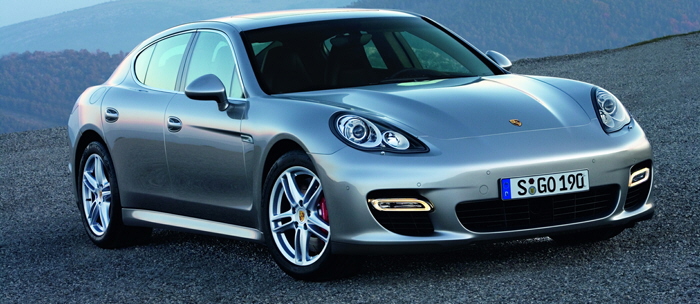
Body: light and functional
The body is the synthesis of lightweight technology typical of a sports car, superior comfort, generous spaciousness, and efficient aerodynamics.
The most advanced production methods and materials are used on the Panamera body. These include all kinds of steel grades, light alloys such as aluminum and magnesium, as well as plastics. The lightweight doors feature a load-bearing structure made of laser-treated pressure-cast aluminum, an aluminum outer skin and door window frames made of thin-walled pressure-cast magnesium. Thanks to this intelligent lightweight structure, the Panamera S, for example, weighs just 1,800 kg, or a just over 3,990 lbs.
The rear seats set new standards in the luxury performance class in terms of both comfort and variability. Perfectly contoured as single seats, they offer maximum comfort also at the rear through their wide range of electrical adjustment and seat climate functions and the headrests integrated into the seats.
The Panamera also comes with a highly functional, variable luggage compartment. The rear seat backrests tilt forward individually, providing up to 44.6 cubic feet or 1,263 liters of luggage capacity.
The visible highlight of the overall aerodynamic package is the active four-way rear spoiler on the Panamera Turbo. Through its efficient management of control angles and surface geometry geared to driving conditions, the rear spoiler optimizes both the car’s aerodynamics and performance.

Acoustics: sporting sound and superior touring comfort
Porsche’s development engineers have successfully achieved a perfect balance of sound of the exhaust system, the air intake, the engine, and the car’s aerodynamic acoustics. The result gives the Panamera a harmonious, characteristic sound pattern, bringing together seemingly contradictory requirements.
At a very early point in the development process, for example, Porsche engineers analyzed aerodynamic acoustics on a clay model right from the start, achieving further optimization by way of numerous technical improvements with specific, individual effects. The result is a truly low level of noise within the interior and most appropriate for the luxury performance segment. But at the same time the typical powerful Porsche sound comes out clearly when accelerating, giving the Panamera a wide range of sound, from discreet modesty while cruising all the way to powerful emotion whenever the driver wishes to experience a sporting style of motoring.
Using both new and proven technologies, Porsche’s engineers in Weissach while developing the Panamera have succeeded in intelligently solving all conflicts of interest. The result is a car with a wide range of features most appropriate for such an outstanding gran turismo: the engines are powerful and dynamic, efficient and clean. The Panamera combines comfortable touring characteristics with sports motoring so typical of Porsche. And despite the car’s dynamic proportions and coupe-like silhouette, the interior, apart from lots of space and superior comfort, also offers outstanding function and variability.
